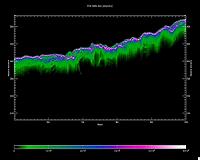 |
Bonn, Germany (SPX) Jul 06, 2010 From the ground, the famous Nazca lines in Peru don't look like much. It is only when you look at them from a height that the mysterious drawings on the stony desert floor come to life. The German Aerospace Center, TerraSAR-X radar satellite has seen them from space, providing a new view of this 2000-year-old World Heritage Site. The geoglyphs show up as dark grooves in the ground in the vicinity of the small town of Palpa - which can be seen as a set of lighter dots in the picture. They can be seen on the radar images as a dark cross. The desert surface in this area normally consists of loose, rough stony ground, but in some areas this stony cover, coated with a black 'desert lacquer', is missing. In such areas we can see the lighter, finer under-surface. The stone heaps can be seen as a low wall at the edges of the clearings. The picture also clearly shows the town of Llipata to the south, as well as the Pan Americana highway, running as a narrow black line through green fields and the reddish stony desert. The dry bed of the Rio Viscas, through which water flows for only four to six weeks a year, runs almost parallel to the highway.
World Heritage Site The lines have many different forms: those in the Palpa valley are mostly geometrical, like the lines in the picture, while those in the Pampa de Nazca, 15 to 20 km to the South, depict a man, an ape and a hummingbird. UNESCO designated the Nazca geoglyphs a World Heritage Site in 1994, declaring the desert glyphs a unique testimony to a long lost culture and a masterpiece of human creativity.
TerraSAR-X shows changes in the landscape Red areas have not changed during the time between the two pictures. The glyphs are especially unchanged, since the Peruvian desert is extremely dry. "On average, the region only experiences 10 mm precipitation every year." Erosion due to flowing water is thus almost unheard of. For scientists, the Nazca glyphs are of value primarily as a reference surface: "It helps us determine the effect on the surface roughness with radar very precisely." The scientists use TerraSAR-X to investigate how the dry valleys change from year to year, and how this is related to climate events such as El Nino. "For a geomorphologist like me, the radar images from TerraSAR-X are absolutely fascinating."
Share This Article With Planet Earth
Related Links German Aerospace Center (DLR) Earth Observation News - Suppiliers, Technology and Application
 CryoSat-2 Exceeding Expectations
CryoSat-2 Exceeding ExpectationsBergen, Norway (ESA) Jul 02, 2010 Today, participants at the Living Planet Symposium have been hearing about ESA's most recently launched mission, CryoSat-2. In orbit for almost three months, the satellite is in excellent health with scientists very encouraged by the first ice-thickness data presented at the symposium. Prof. Duncan Wingham, Lead Investigator for the CryoSat mission, stated, "The satellite is in very good s ... read more |
|
| The content herein, unless otherwise known to be public domain, are Copyright 1995-2010 - SpaceDaily. AFP and UPI Wire Stories are copyright Agence France-Presse and United Press International. ESA Portal Reports are copyright European Space Agency. All NASA sourced material is public domain. Additional copyrights may apply in whole or part to other bona fide parties. Advertising does not imply endorsement,agreement or approval of any opinions, statements or information provided by SpaceDaily on any Web page published or hosted by SpaceDaily. Privacy Statement |